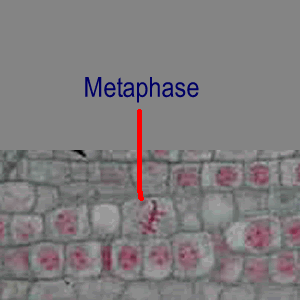How Is Mitosis Different In Plants And Animals
Mitosis in plants and animals
Microscopy - Instructor's Guide
SED 695B; Fall 2005


Onion root
Whitefish Blastula
Topics addressed
Description of Investigation
- Mitotic bicycle
- The role of Chromosomes in heredity
- Comparison of plant and creature cells
Today you will apply prepared slides to investigate the phases of mitosis in both plants and animals.
- Longitudinal sections of the root of Allium, will exist used to examine the cells in the root meristem, the growing region of the root.
- Whole mounts of whitefish blastula volition illustrate reproductive cells in animals. These undifferentiated cells undergo mitosis at a regular interval as the embryo increases in number of cells and complexity.
- You will make observational drawings and be prepared to take a applied quiz.
Standards:
Loftier School:
Cell Biology one. The fundamental life processes of plants and animals depend on a variety of chemical reactions that occur in specialized areas of the organism'south cells. As a basis for understanding this concept:
c.
Students know how prokaryotic cells, eukaryotic cells (including those from plants and animals), and viruses differ in complication and full general construction.
Heart School:
Cell Biology 1. All living organisms are composed of cells, from just one to many trillions, whose details ordinarily are visible merely through a microscope. As a ground for understanding this concept:
b.
Students know the characteristics that distinguish institute cells from animal cells, including chloroplasts and cell walls. c.
Students know the nucleus is the repository for genetic information in plant and fauna cells. east.
Students know cells divide to increase their numbers through a process of mitosis, which results in two daughter cells with identical sets of chromosomes. f.
Students know that as multicellular organisms develop, their cells differentiate.
Study Guide:
Plant and Animal Mitosis
Your objective:
Find and make observations of cells in each phase of mitosis in plant and creature tissue. Compare the differences between constitute and animal mitosis. Exist able to correctly place the phases from both plant and brute tissue.
Materials:
- Prepared slide labeled 'Allium root, mitosis'
- Prepared slide labeled 'whitefish blastula, mitosis'
- compound microscope
Procedures:
- Prepare your microscope, identify the onion root slide on the stage and focus on low (40x) power.
- motility your slide then that your field of view is centered on the root tip.
- Focus at 100x and re eye so that you are focused on the more 'square' meristem cells.
- Focus at 400x.
- Slowly motion the slide and search for cells in each phase of mitosis
- When you have establish one, make a detailed observational drawing of that cell. Characterization all important structures (nucleus, chromosome, cell plate). Title the cartoon with the type of jail cell, magnification, and phase of mitosis.
- Continue with your observations until y'all have found cells in each phase and both you and your partner can easily place each phase.
- Remove the onion root slide and supersede it with the whitefish blastula slide. Focus and eye at 40x, 100x, and 400x magnification.
- As instructed to a higher place, locate and make observational drawings of each stage of mitosis.
- Respond the questions beneath and so let your instructor know you are ready for your practical quiz.
Questions:
- Which cells (plat or animal) shows the most regularity in the direction in which it divides? Requite an caption for this divergence.
- What testify of cytokinesis is visible in telophase in the onion root cells? Do you accept this evidence in your cartoon?
- What testify of cytokinesis is visible in telophase in the whitefish cells? Do you take this evidence in your cartoon?
Onion Root
Whitefish Blastula










References & Links:
Cells Alive: mitosis animation
University of Arizona Tutorial
Stephen Wolniak, U. of Maryland. Tutorial with high magnification photos
Source: https://www.csun.edu/scied/7-microscopy/mitosis/index.html
Posted by: confernotilen.blogspot.com

0 Response to "How Is Mitosis Different In Plants And Animals"
Post a Comment